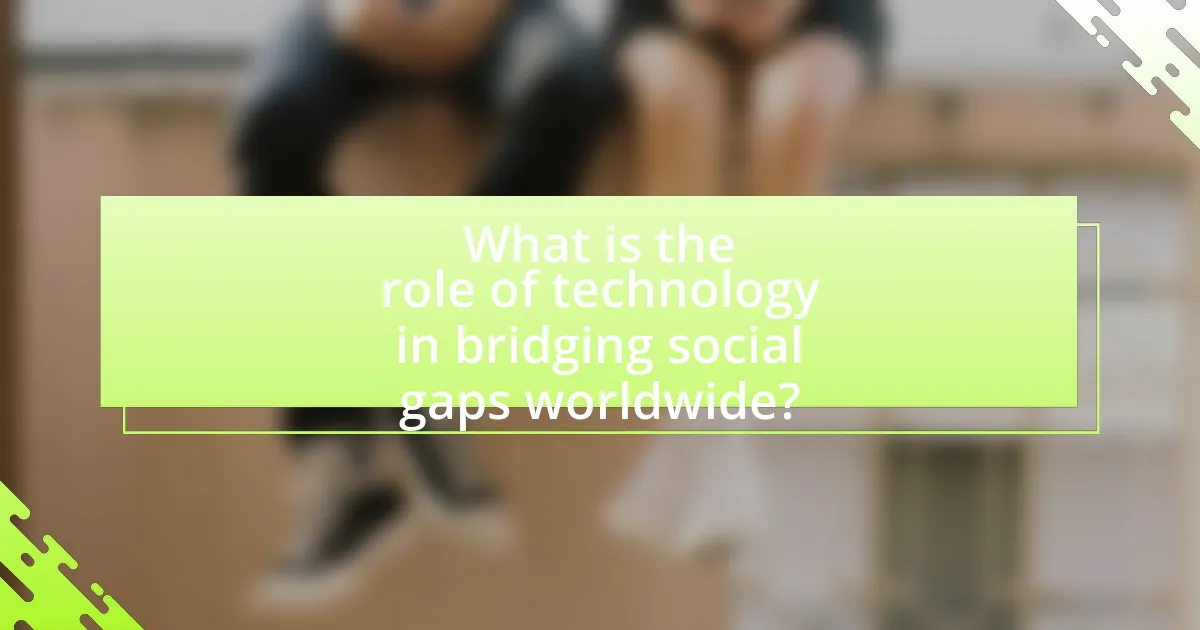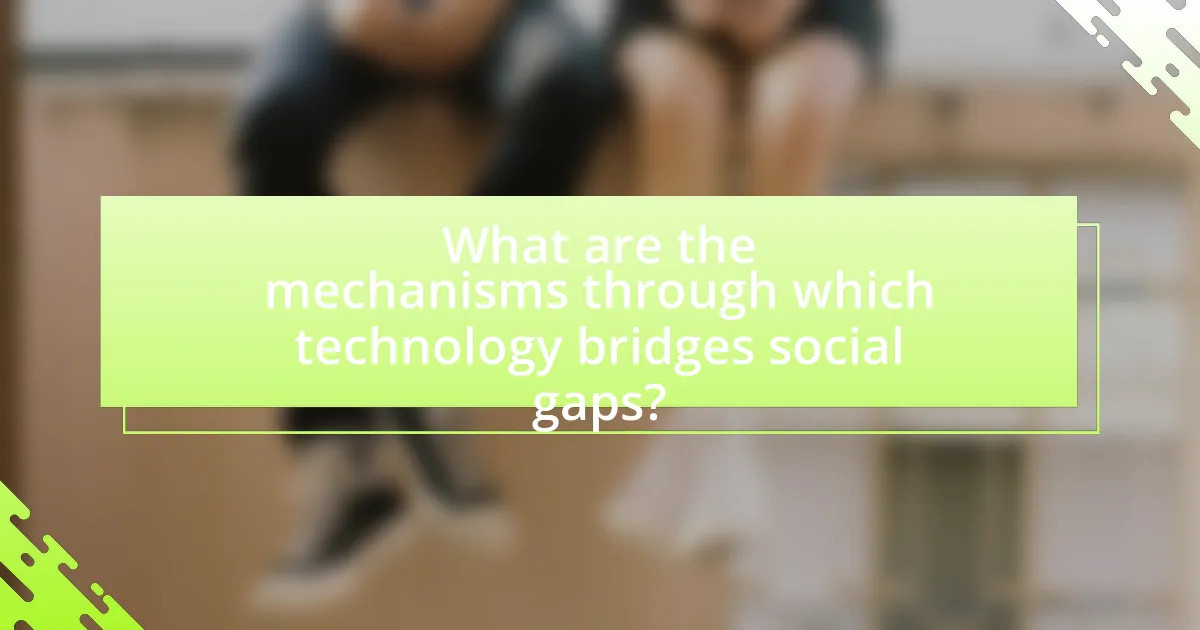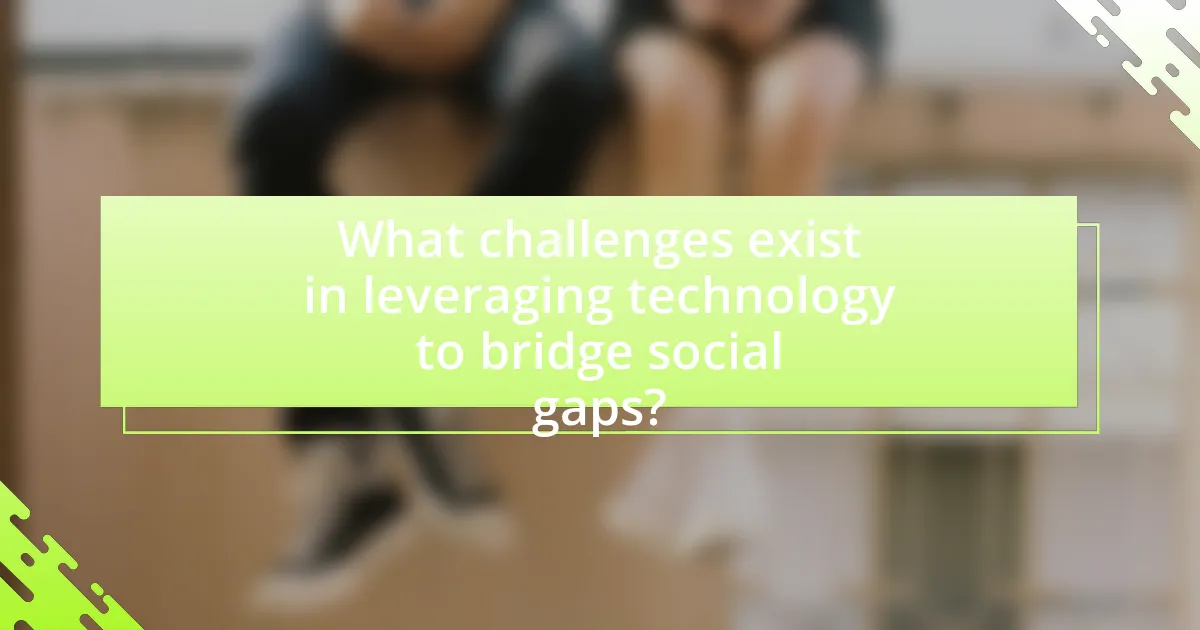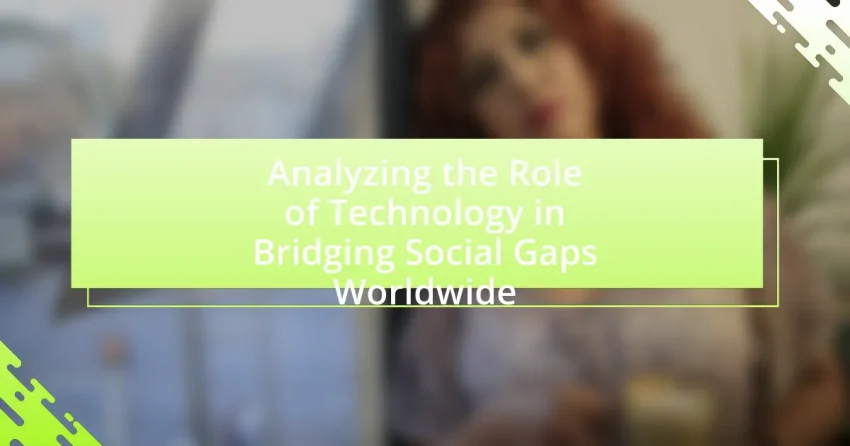The article analyzes the role of technology in bridging social gaps worldwide, highlighting its impact on communication, access to information, and economic opportunities. It discusses how mobile technology, social media, and online platforms facilitate educational access, healthcare services, and financial inclusion, particularly for marginalized communities. The article also examines the challenges posed by the digital divide, accessibility issues, and socio-economic disparities, while emphasizing the importance of stakeholder collaboration and inclusive practices in technology development to enhance social equity. Key innovations and best practices are presented to illustrate how technology can effectively address social inequalities and improve civic engagement among underrepresented groups.

What is the role of technology in bridging social gaps worldwide?
Technology plays a crucial role in bridging social gaps worldwide by enhancing communication, access to information, and economic opportunities. For instance, mobile technology has enabled millions in developing countries to access educational resources and financial services, significantly reducing the digital divide. According to a report by the International Telecommunication Union, internet access can increase economic growth by up to 1.38% in developing nations, demonstrating how technology fosters inclusivity and economic participation. Furthermore, social media platforms facilitate global connections, allowing marginalized voices to be heard and promoting social movements, as seen in the Arab Spring and Black Lives Matter movements. Thus, technology serves as a powerful tool for social equity and empowerment across diverse populations.
How does technology influence social interactions across different cultures?
Technology significantly influences social interactions across different cultures by facilitating communication, enabling cultural exchange, and shaping social norms. For instance, social media platforms like Facebook and WhatsApp allow individuals from diverse backgrounds to connect instantly, fostering relationships that transcend geographical boundaries. A study by Pew Research Center in 2021 found that 72% of adults use social media, which enhances cross-cultural interactions by providing a space for sharing cultural practices and perspectives. Additionally, technology enables access to information about different cultures, promoting understanding and reducing stereotypes. This interconnectedness can lead to a more globalized society where cultural appreciation and collaboration are enhanced.
What specific technologies are most effective in fostering cross-cultural communication?
Video conferencing platforms, social media, and translation applications are the most effective technologies in fostering cross-cultural communication. Video conferencing platforms like Zoom and Microsoft Teams enable real-time face-to-face interactions, allowing participants from different cultures to engage visually and verbally, which enhances understanding and reduces miscommunication. Social media platforms such as Facebook and Twitter facilitate the sharing of cultural content and ideas, promoting dialogue and interaction among diverse groups. Translation applications like Google Translate provide instant language translation, breaking down language barriers and enabling individuals to communicate effectively despite linguistic differences. These technologies collectively enhance cross-cultural communication by providing tools that support interaction, understanding, and collaboration across diverse cultural contexts.
How do social media platforms contribute to bridging social divides?
Social media platforms contribute to bridging social divides by facilitating communication and interaction among diverse groups. These platforms enable users from different backgrounds to share experiences, ideas, and perspectives, fostering understanding and empathy. For instance, studies show that social media can reduce prejudice by exposing users to varied viewpoints, as evidenced by research from the Pew Research Center, which found that 70% of social media users reported encountering opinions different from their own. This exposure can lead to increased tolerance and social cohesion, effectively narrowing social divides.
What are the key social gaps that technology aims to bridge?
Technology aims to bridge key social gaps such as access to education, healthcare, and economic opportunities. For instance, online learning platforms provide educational resources to underserved communities, enabling access to quality education regardless of geographical location. Telemedicine applications enhance healthcare access for remote populations, allowing patients to consult with healthcare professionals without the need for travel. Additionally, technology facilitates economic opportunities through e-commerce platforms that empower small businesses and entrepreneurs in developing regions, promoting financial inclusion. These examples illustrate how technology addresses disparities in education, healthcare, and economic participation, ultimately fostering greater social equity.
How does technology address economic disparities in various regions?
Technology addresses economic disparities in various regions by enhancing access to information, improving communication, and facilitating economic opportunities. For instance, mobile banking services like M-Pesa in Kenya have enabled millions to access financial services, significantly increasing economic participation among previously unbanked populations. According to a study by the Consultative Group to Assist the Poor, M-Pesa has lifted approximately 194,000 households out of poverty. Additionally, e-learning platforms provide educational resources to remote areas, bridging the knowledge gap and fostering skill development. The World Bank reports that digital education initiatives can increase learning outcomes and economic mobility in underserved regions. Thus, technology serves as a critical tool in reducing economic disparities by promoting financial inclusion and educational access.
In what ways does technology enhance access to education for marginalized communities?
Technology enhances access to education for marginalized communities by providing online learning platforms, enabling remote access to educational resources, and facilitating communication between students and educators. Online learning platforms, such as Khan Academy and Coursera, offer free or low-cost courses that can be accessed from anywhere, breaking geographical barriers. Remote access to educational resources, including e-books and digital libraries, allows individuals in underserved areas to obtain materials that were previously unavailable. Furthermore, technology facilitates communication through tools like video conferencing and messaging apps, which connect students with teachers and peers, fostering a collaborative learning environment. According to a report by UNESCO, the use of technology in education can significantly improve learning outcomes, particularly in low-income regions, by making quality education more accessible.
Why is it important to analyze the impact of technology on social gaps?
Analyzing the impact of technology on social gaps is crucial because it reveals how technological advancements can either exacerbate or mitigate inequalities within society. For instance, studies show that access to the internet and digital tools significantly influences educational and economic opportunities, with the digital divide affecting marginalized communities disproportionately. According to the Pew Research Center, as of 2021, 27% of lower-income households lacked broadband access, limiting their ability to participate in the digital economy. Understanding these dynamics allows policymakers and stakeholders to implement targeted interventions that promote equitable access to technology, thereby fostering social inclusion and reducing disparities.
What are the potential risks of technology exacerbating existing social divides?
The potential risks of technology exacerbating existing social divides include increased inequality in access to resources, information, and opportunities. For instance, individuals in low-income communities often lack access to high-speed internet and advanced technologies, which can hinder their educational and economic prospects. According to a report by the Pew Research Center, 25% of lower-income households in the U.S. do not have broadband internet, limiting their ability to participate in the digital economy. Additionally, technology can reinforce existing biases, as algorithms used in social media and job recruitment may favor certain demographics over others, perpetuating discrimination. This can lead to a widening gap between those who can leverage technology for advancement and those who cannot, ultimately entrenching social divides.
How can understanding technology’s role lead to better policy-making?
Understanding technology’s role can lead to better policy-making by enabling policymakers to make informed decisions based on data-driven insights. When policymakers comprehend how technology influences social dynamics, they can design policies that effectively address issues such as digital inequality and access to information. For instance, research from the Pew Research Center indicates that technology adoption can significantly impact economic opportunities, highlighting the need for policies that promote equitable access to technology. By leveraging this understanding, policymakers can create frameworks that not only enhance technological integration but also ensure that marginalized communities benefit from advancements, ultimately bridging social gaps.

What are the mechanisms through which technology bridges social gaps?
Technology bridges social gaps primarily through enhanced communication, access to information, and economic opportunities. Enhanced communication platforms, such as social media and messaging apps, enable individuals from diverse backgrounds to connect, share experiences, and collaborate, fostering understanding and reducing isolation. Access to information is facilitated by the internet, which provides educational resources and knowledge that were previously unavailable to marginalized communities, thereby empowering individuals to improve their socio-economic status. Economic opportunities arise through e-commerce and remote work platforms, allowing individuals in underserved areas to participate in the global economy, thus reducing income disparities. For instance, a report by the International Telecommunication Union indicates that increased internet access can lead to a 1.38% increase in GDP per capita, demonstrating the economic impact of technology in bridging social gaps.
How does technology facilitate access to essential services?
Technology facilitates access to essential services by providing platforms and tools that enhance communication, streamline processes, and improve service delivery. For instance, telemedicine allows patients to consult healthcare providers remotely, significantly increasing access to medical care, especially in rural areas. According to a study published in the Journal of Medical Internet Research, telehealth services expanded by over 154% during the COVID-19 pandemic, demonstrating how technology can bridge gaps in healthcare access. Additionally, mobile banking applications enable individuals in underserved regions to perform financial transactions without needing physical bank branches, thereby promoting financial inclusion. The World Bank reported that mobile money services have reached over 1 billion users globally, highlighting technology’s role in facilitating access to essential financial services.
What role do mobile applications play in improving healthcare access?
Mobile applications significantly enhance healthcare access by providing users with immediate access to medical information, services, and professionals. These applications facilitate telemedicine, allowing patients to consult healthcare providers remotely, which is particularly beneficial in underserved or rural areas where medical facilities may be scarce. According to a study published in the Journal of Medical Internet Research, telehealth services increased by 154% during the COVID-19 pandemic, demonstrating the effectiveness of mobile applications in connecting patients with healthcare resources. Additionally, mobile health apps enable users to manage chronic conditions, schedule appointments, and receive reminders for medication, further improving patient engagement and adherence to treatment plans.
How does e-governance enhance civic engagement among underrepresented groups?
E-governance enhances civic engagement among underrepresented groups by providing accessible platforms for participation and communication. These digital platforms facilitate easier access to information, enabling marginalized communities to engage in decision-making processes that affect their lives. For instance, studies show that online tools and social media campaigns have increased voter registration and participation rates among minority populations, as they can share their concerns and mobilize support more effectively. Additionally, e-governance initiatives often include features like multilingual support and user-friendly interfaces, which further empower these groups to voice their opinions and influence public policy.
What innovations have emerged to specifically target social inequalities?
Innovations that have emerged to specifically target social inequalities include mobile banking, telemedicine, and online education platforms. Mobile banking applications, such as M-Pesa, have enabled unbanked populations to access financial services, significantly increasing economic participation among marginalized communities. Telemedicine solutions, like Doctor on Demand, provide remote healthcare access, reducing barriers for low-income individuals who may lack transportation or insurance. Online education platforms, such as Khan Academy, offer free educational resources, helping to bridge the knowledge gap for students in underserved areas. These innovations demonstrate measurable impacts, such as increased financial inclusion rates, improved health outcomes, and enhanced educational access, thereby addressing social inequalities effectively.
How are fintech solutions helping to reduce financial exclusion?
Fintech solutions are helping to reduce financial exclusion by providing accessible financial services to underserved populations. These technologies, such as mobile banking and digital wallets, enable individuals without traditional banking access to perform transactions, save money, and obtain credit. For instance, according to a report by the World Bank, mobile money services have increased financial inclusion rates in regions like Sub-Saharan Africa, where over 50% of adults now use mobile money accounts. This shift allows previously excluded individuals to participate in the economy, improving their financial stability and opportunities.
What impact do online learning platforms have on educational equity?
Online learning platforms significantly enhance educational equity by providing access to quality educational resources for diverse populations. These platforms eliminate geographical barriers, allowing students from underserved areas to access the same materials and instruction as those in more affluent regions. For instance, a study by the Brookings Institution found that online learning can reduce achievement gaps by offering tailored learning experiences that cater to individual needs, thus promoting inclusivity. Furthermore, platforms like Coursera and Khan Academy offer free or low-cost courses, making education more affordable and accessible, which is crucial for low-income students. This democratization of education through technology plays a vital role in leveling the playing field for all learners.

What challenges exist in leveraging technology to bridge social gaps?
The challenges in leveraging technology to bridge social gaps include digital divide, accessibility issues, and socio-economic disparities. The digital divide refers to the gap between those who have easy access to digital technology and those who do not, which can exacerbate existing inequalities. Accessibility issues arise when technology is not designed to accommodate all users, particularly individuals with disabilities, limiting their ability to benefit from technological advancements. Socio-economic disparities further complicate the situation, as individuals from lower-income backgrounds may lack the resources to access or utilize technology effectively. According to a report by the International Telecommunication Union, approximately 3.7 billion people remain unconnected to the internet, highlighting the scale of the digital divide and its impact on social equity.
What are the barriers to technology adoption in underserved communities?
Barriers to technology adoption in underserved communities include lack of access to affordable internet, limited digital literacy, and insufficient financial resources. Research indicates that approximately 25% of rural Americans lack access to broadband, which significantly hinders their ability to utilize technology effectively. Additionally, a report by the Pew Research Center found that 43% of lower-income households do not own a smartphone, further limiting their engagement with digital tools. These factors collectively create a significant gap in technology adoption, preventing underserved communities from fully participating in the digital economy and accessing essential services.
How does the digital divide affect access to technology?
The digital divide significantly limits access to technology for marginalized populations. This divide manifests as disparities in internet connectivity, device availability, and digital literacy, which hinder individuals from fully participating in the digital economy and accessing essential services. For instance, according to the Pew Research Center, as of 2021, 27% of adults in lower-income households reported not having a smartphone, compared to only 3% in higher-income households. This lack of access restricts opportunities for education, employment, and social engagement, further entrenching socioeconomic inequalities.
What role does infrastructure play in technology accessibility?
Infrastructure is crucial for technology accessibility as it provides the necessary physical and digital frameworks that enable connectivity and access to technology. Reliable internet infrastructure, such as broadband networks, ensures that individuals can access online resources, educational materials, and digital services. According to the International Telecommunication Union, as of 2021, 93% of the global population lives within range of a mobile network, highlighting the importance of infrastructure in bridging the digital divide. Furthermore, well-developed transportation infrastructure facilitates the distribution of technology devices and services, making them available to underserved communities. Thus, infrastructure directly influences the extent to which technology can be accessed and utilized by different populations.
How can stakeholders collaborate to overcome these challenges?
Stakeholders can collaborate to overcome challenges by establishing partnerships that leverage technology for effective communication and resource sharing. For instance, public-private partnerships can facilitate the development of digital platforms that connect marginalized communities with essential services, thereby addressing social gaps. Research indicates that collaborative initiatives, such as the Global Partnership for Education, have successfully mobilized resources and expertise to enhance educational access in underserved regions, demonstrating the effectiveness of stakeholder collaboration in overcoming systemic challenges.
What partnerships are essential for promoting technology access?
Public-private partnerships are essential for promoting technology access. These collaborations leverage resources, expertise, and infrastructure from both sectors to enhance technology availability and affordability. For instance, initiatives like the Global Partnership for Education have successfully mobilized funding and resources from governments and private companies to improve digital learning tools in underserved areas. Additionally, partnerships between non-profit organizations and tech companies, such as the collaboration between Google and the non-profit organization One Laptop per Child, have provided low-cost laptops to children in developing countries, significantly increasing their access to technology.
How can community engagement enhance technology initiatives?
Community engagement enhances technology initiatives by fostering collaboration and ensuring that technological solutions address the actual needs of the community. When communities actively participate in the development and implementation of technology, they provide valuable insights that lead to more relevant and effective solutions. For instance, a study by the Pew Research Center found that community-driven technology projects, such as local broadband initiatives, resulted in higher adoption rates and user satisfaction because they were tailored to the specific needs and preferences of the community. This alignment between technology and community needs not only improves the effectiveness of the initiatives but also builds trust and encourages ongoing participation, ultimately leading to sustainable technological advancements.
What best practices can be implemented to maximize technology’s impact on social gaps?
To maximize technology’s impact on social gaps, implementing inclusive digital literacy programs is essential. These programs equip marginalized communities with the skills needed to navigate and utilize technology effectively, thereby reducing disparities in access and usage. For instance, a study by the Pew Research Center found that individuals with higher digital literacy are more likely to benefit from online resources, leading to improved educational and economic outcomes. Additionally, fostering partnerships between tech companies and local organizations can enhance resource distribution and support tailored solutions that address specific community needs. This collaborative approach has been shown to increase technology adoption rates and improve overall social equity.
How can organizations ensure inclusivity in technology development?
Organizations can ensure inclusivity in technology development by actively involving diverse stakeholders throughout the development process. This approach includes engaging underrepresented groups in user research, design, and testing phases to gather a wide range of perspectives and needs. For instance, a study by the National Center for Women & Information Technology found that diverse teams are 35% more likely to outperform their peers, highlighting the value of inclusivity in driving innovation and better solutions. Additionally, implementing accessibility standards, such as the Web Content Accessibility Guidelines (WCAG), ensures that technology is usable by individuals with disabilities, further promoting inclusivity.
What strategies can be employed to measure the effectiveness of technology in bridging social gaps?
To measure the effectiveness of technology in bridging social gaps, strategies such as quantitative surveys, qualitative interviews, and data analytics can be employed. Quantitative surveys can assess user engagement and satisfaction levels among diverse demographic groups, providing statistical evidence of technology’s impact on social inclusion. Qualitative interviews can capture personal experiences and narratives that highlight how technology has facilitated connections and reduced barriers. Data analytics can track usage patterns and outcomes, such as improvements in education or employment opportunities, demonstrating measurable changes in social equity. For instance, a study by the Pew Research Center found that 73% of Americans believe that technology has improved access to information, which supports the notion that technology can effectively bridge social gaps.
